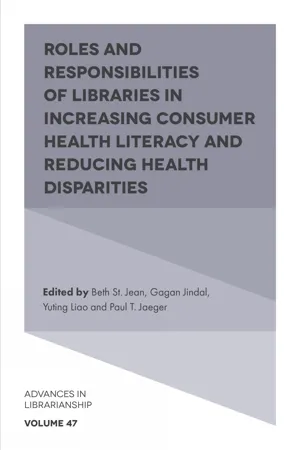
Roles and Responsibilities of Libraries in Increasing Consumer Health Literacy and Reducing Health Disparities
- 368 pages
- English
- ePUB (mobile friendly)
- Available on iOS & Android
Roles and Responsibilities of Libraries in Increasing Consumer Health Literacy and Reducing Health Disparities
About This Book
The rampant health injustices that occur daily throughout the world are exacerbated by health information injustice – something which libraries and librarians play an instrumental role in addressing. This volume brings together librarians, LIS students, educators, and researchers, to discuss the many ways that information professionals and libraries serve as agents of securing health information justice.
Kicking off with an introductory chapter which covers the central concepts of health information injustice, the following chapters focus on the roles of libraries and librarians in improving consumer health literacy and reducing health disparities in their communities. In the final chapter, the editors draw on the authors' work to highlight the ways in which libraries and librarians are moving us closer to health justice, and they also discuss how the COVID-19 pandemic is both illuminating and intensifying health disparities, reinforcing the need for libraries and librarians to continue their important roles as agents of health information justice to ensure the physical and intellectual accessibility of information for all.
Frequently asked questions
Information
Table of contents
- Cover
- Title
- INTRODUCTION
- Chapter 1 Introduction: Libraries and Librarians as Agents of Health Information Justice
- PUBLIC LIBRARIES/HEALTHY COMMUNITIES
- Chapter 2 Consumer Health Literacy, the National Library of Medicine, and the Public Library: Bridging the Gaps
- Chapter 3 Growing Food at and through the Local Library: An Exploratory Study of an Emerging Role
- Chapter 4 Opioid Consumer Health Information Literacies in Alabama’s Public Libraries: An Exploratory Website Content Analysis
- Chapter 5 Applying a Health Justice Framework to Examine Health and Social Justice in LIS Course Offerings
- HEALTH INFORMATION ASSESSMENT
- Chapter 6 Consumer Health Information Literacy and Information Behavior of Young Adults
- Chapter 7 Asking Good Questions: Developing Skilled Health Information Consumers
- OVERCOMING BARRIERS TO HEALTH INFORMATION ACCESS
- Chapter 8 Making Health Information Accessible for All:The Impact of Universal Design in Public Libraries
- Chapter 9 Sexual Education is a Human Right: Information Inequities of K-12 Sexual Education and Librarians’ Roles in Supporting Adolescents’ Sexual Health Literacy
- SERVING DISADVANTAGED POPULATIONS
- Chapter 10 Public Libraries Expanding Health Literacy for Drug Court Participants
- Chapter 11 Increasing Health Literacy in Rural Appalachia Tennessee through Outreach, Communication, and Education: How Libraries Can Reduce Health Disparities in their Communities
- Chapter 12 The Health of a Musician: Documenting and Addressing Health Disparities among Performing Musicians
- HEALTH INFORMATION AS A COMMUNAL ASSET
- Chapter 13 (Im)patient Narratives: Peer-to-Peer Health Information Transfer in the LGBTQ+ Community via Zines from the Queer Zine Archive Project (QZAP)
- Chapter 14 “When It’s Time to Come Together, We Come Together”: Reconceptualizing Theories of Self-Efficacy for Health Information Practices within LGBTQIA+ Communities
- CONCLUSION
- Chapter 15 Libraries and Librarians as Agents of Health Information Justice: Concluding Thoughts
- Index